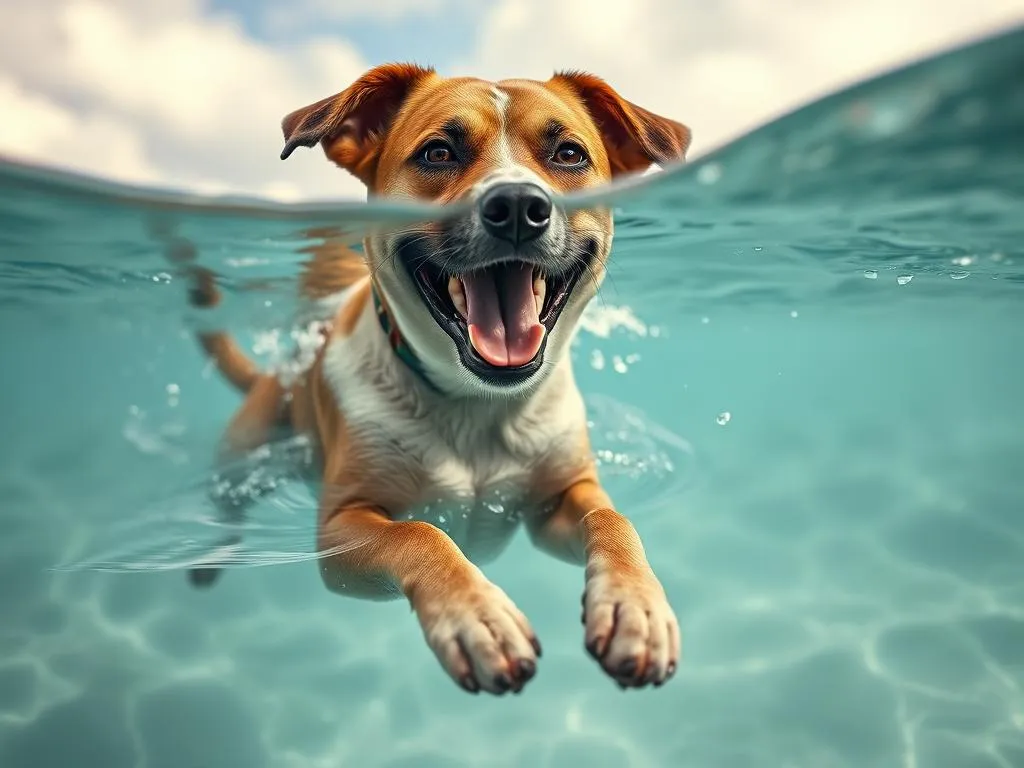
Introduction
There’s something undeniably captivating about watching dogs swim. Whether it’s a Labrador Retriever joyfully splashing around in a lake or a Golden Retriever diving into the ocean, many dog owners wonder: do dogs naturally know how to swim? This question is essential for pet owners who want to ensure their furry friends are safe and happy around water. Understanding a dog’s natural swimming instincts can help owners make informed decisions about water activities and training.
In this article, we will explore the origins of dogs and their relationship with swimming, identify which breeds are natural swimmers, and discuss safety measures and health benefits associated with swimming. By the end, you’ll have a comprehensive understanding of whether dogs are born swimmers and what you can do to make water time enjoyable and safe for your canine companion.
The Origins of Dogs and Swimming
Evolutionary Background
To understand if dogs naturally know how to swim, we must first look back at their evolutionary roots. Dogs descended from wolves, which are often associated with various habitats, including rivers and lakes. Over thousands of years, selective breeding has led to the development of specific breeds that thrive in aquatic environments. For instance, breeds like Labrador Retrievers, Newfoundlands, and Spaniels have been bred for their swimming abilities, often assisting hunters in retrieving waterfowl.
These breeds have a significant history of working in or around water, giving them natural traits conducive to swimming. Their webbed feet, strong build, and waterproof coats make them well-suited for aquatic activities, indicating that some dogs possess innate swimming capabilities.
Instinctual Behaviors
Beyond evolutionary adaptations, dogs also exhibit instinctual behaviors that contribute to their swimming ability. One such behavior is the “dog paddle,” a natural swimming technique observed in many dogs. When a dog finds itself in water, it instinctively begins to paddle with its legs, mimicking a swimming motion. This innate response is biologically driven and helps them stay afloat, showcasing that many dogs have a natural propensity for swimming.
Do All Dogs Know How to Swim?
Breed Differences
While some dogs are born swimmers, not all breeds share the same affinity for water. Breeds like Labrador Retrievers, Newfoundlands, and Portuguese Water Dogs are typically excellent swimmers thanks to their physical characteristics and historical roles. These dogs are genetically inclined to enjoy and excel in swimming activities.
Conversely, certain breeds may struggle with swimming due to their body structure. For example, Bulldogs and Dachshunds may find it challenging to swim effectively. Bulldogs have heavy heads and short legs, making it difficult for them to maintain buoyancy. Similarly, Dachshunds, with their elongated bodies, are not built for swimming, which can lead to discomfort and distress in water.
Individual Variation
Beyond breed characteristics, individual variation plays a significant role in whether a dog will enjoy swimming. Some dogs may have a natural inclination to the water due to positive experiences during their formative months. If a dog is introduced to water early on and has enjoyable experiences, it may develop a love for swimming. Conversely, a negative experience in the water—such as a near-drowning incident—could lead to a fear of water, regardless of breed.
Additionally, a dog’s personality can influence its comfort level in water. Some dogs are more adventurous and curious, while others may be more cautious or anxious. Understanding your dog’s unique traits can help you determine whether they are likely to enjoy swimming or need more encouragement and training.
Signs That Your Dog May Be a Natural Swimmer
Body Language in Water
Recognizing your dog’s body language can provide insights into whether they are comfortable in the water. A dog that is a natural swimmer may display enthusiastic behaviors such as jumping into the water, splashing around, and paddling energetically. Conversely, signs of distress may include excessive barking, attempts to climb out of the water, or a stiff body posture.
Observing how your dog reacts when they encounter water can help you gauge their natural swimming instincts. A relaxed and playful demeanor often indicates a comfort level that suggests they may be inclined to swim.
Natural Swimming Techniques
Most dogs use a technique known as the dog paddle when swimming. This involves moving their legs in a circular motion, which allows them to stay afloat. Dogs also have a natural buoyancy due to their body composition, making it easier for them to stay on the surface. This swimming technique is generally efficient, allowing dogs to swim long distances without tiring quickly.
It’s worth noting that dogs swim differently than humans or other animals. For example, while humans rely on a coordinated stroke, dogs primarily use their legs to paddle and their body to maintain balance. This unique swimming style contributes to their ability to thrive in water and showcases the diversity of swimming techniques across species.
Safety Considerations for Swimming Dogs
Supervision and Environment
While many dogs may possess natural swimming abilities, safety should always be a top priority. Adult supervision is vital whenever dogs are in or near water. Unforeseen hazards, such as strong currents, deep water, or underwater debris, can pose risks even to experienced swimmers.
Choosing safe locations for swimming is essential. Look for calm, shallow areas where your dog can enter and exit easily. Avoid locations with strong currents or murky waters, which can be disorienting. Additionally, be mindful of temperature; hot weather can lead to overheating, while cold water can be dangerous for some breeds.
Swim Training
Introducing your dog to water should be done gradually and safely. Start by allowing them to explore shallow areas where they can get accustomed to the sensation of water. Use positive reinforcement, such as treats and praise, to encourage them to enter the water. As your dog becomes more confident, you can gradually increase the depth of the water.
Basic swimming commands, such as “come” or “stay,” can be beneficial during swimming sessions. Teaching your dog these commands helps maintain control and ensures their safety while they enjoy their time in the water. Always be patient and observant, adjusting the experience according to your dog’s comfort level.
Health Benefits of Swimming for Dogs
Physical Fitness
Swimming is an excellent form of exercise for dogs, promoting physical fitness and overall health. It provides a low-impact workout that is gentle on joints, making it particularly beneficial for older dogs or those recovering from injury. Swimming engages multiple muscle groups, enhancing strength, endurance, and coordination.
Moreover, because water supports a dog’s weight, swimming is an effective way for dogs to burn calories without straining their bodies. Regular swimming sessions can help maintain a healthy weight and promote cardiovascular health, contributing to a longer, happier life.
Mental Stimulation
In addition to physical benefits, swimming can also provide significant mental stimulation for dogs. Water activities engage their senses, encouraging exploration and play. The combination of splashing, swimming, and retrieving objects can enhance their overall well-being and reduce boredom.
Engaging in water play stimulates a dog’s natural instincts and encourages problem-solving skills, which is essential for their mental health. Playful interactions with their owners during swimming sessions can also strengthen the bond between a dog and its owner, leading to a happier, more fulfilled pet.
Common Myths About Dogs and Swimming
Myth vs. Fact
There are several myths surrounding dogs and swimming that can mislead pet owners. One common myth is that all dogs can swim instinctively. While many dogs possess natural swimming abilities, this is not true for every breed. Some dogs may struggle with swimming due to their body structure or lack of exposure to water.
Another misconception is that dogs inherently enjoy water and swimming. In reality, a dog’s comfort level in water can vary greatly based on individual experiences and temperament. Some dogs may love swimming, while others may fear it, highlighting the importance of understanding your dog’s unique personality.
Cultural Beliefs
Cultural beliefs also play a role in how dogs and water are perceived. In some cultures, dogs are seen as natural swimmers, while in others, they may be viewed as land animals. Media representations of dogs swimming often highlight specific breeds that excel in water, which can skew public perception. It’s essential to recognize that while some dogs are natural swimmers, many others may require training and encouragement.
Conclusion
In summary, the question of whether dogs naturally know how to swim is nuanced. While many breeds exhibit natural swimming abilities due to their evolutionary background and instinctual behaviors, individual variation plays a significant role in comfort levels and swimming proficiency. By observing your dog’s body language, providing safe environments, and engaging in positive water experiences, you can help your canine companion enjoy the benefits of swimming.
Understanding a dog’s natural abilities and preferences is crucial for ensuring their safety and happiness around water. Whether your dog is a born swimmer or needs a little encouragement, swimming can be a rewarding and enjoyable activity for both of you. So, the next time you’re near water, take a moment to assess your dog’s swimming potential and enjoy a fun-filled day in the sun!









